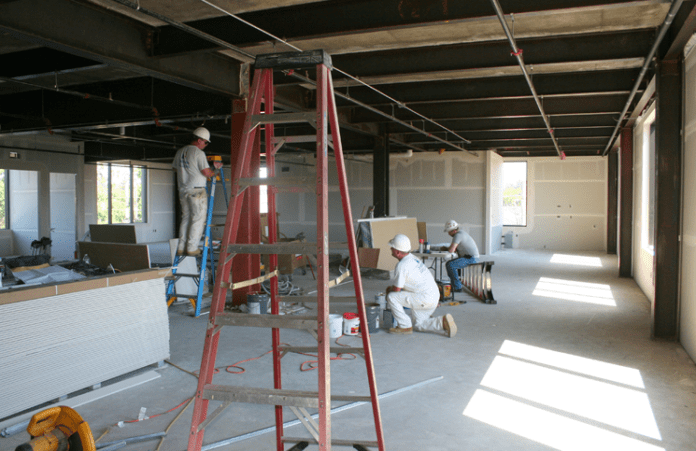For many years, scientists have warned residents throughout the Pacific Northwest about a Cascadia Subduction Zone mega earthquake and tsunami. Then, in July, a New Yorker article titled “The Really Big One” provoked a lot of buzz and worry – so much so that it helped to inspire an Earthquake Resilience Summit in Washington D.C., which was held earlier this week.
The mega earthquake is predicted to be near 9.0 in magnitude and last for several minutes. Thousands of lives are expected to be lost and hundreds of thousands of buildings (or more) damaged or destroyed.
So what exactly should a business or property owner do with these predictions? That’s the question we posed to local engineers, who said that seismic upgrades of commercial properties are definitely on the rise.
“We like to plan for what may happen,” said Devin Gustafson, marketing coordinator at Vancouver-based WRK Engineers. Gustafson estimated that between 65 and 70 percent of the projects the firm is currently working on are seismic upgrades, an increase over the last five years. “There is steady, upward growth as public utilities want upgrades,” he added.
Allison Pyrch, a geotechnical engineer with the Seattle-based firm Hart Crowser, said it is imperative that private property owners and businesses invest in seismically upgrading their buildings. If they don’t, she said, the local economy could go into a deep recession.
“We know that a small business is out of business within two weeks to a month if they have no business,” she said. “We really need to all consider everybody having a business continuity plan and a long-term resiliency plan.”
 Brandon Erickson, owner of Erickson Structural Consulting Engineers in Vancouver, said that property owners, when thinking about having a seismic upgrade done, need to consider how long their business can be closed after an earthquake that severely damages their building.
Brandon Erickson, owner of Erickson Structural Consulting Engineers in Vancouver, said that property owners, when thinking about having a seismic upgrade done, need to consider how long their business can be closed after an earthquake that severely damages their building.
“You’re going to wish you had done the upgrade,” Erickson said, if closure results in a significant loss of profits or market share.
“There is going to be tremendous competition for construction and engineering services after an earthquake,” he added. “A $500,000 project could easily turn into a $1.5 million project.”
The structural soundness of buildings in Vancouver varies widely, but Erickson and other structural engineers said that the majority of buildings – especially buildings made of unreinforced masonry – will be severely damaged by a large earthquake.
When it comes to seismic upgrades, there is no ‘one size fits all’ approach.
“Each building is unique and each requires a unique upgrade,” Erickson explained.
The types of upgrades that can be done include replacing and bracing sheer wall, reinforcing a building’s walls, foundation, roof, or the connections between those building parts. The cost varies widely by square foot and ultimately depends on what a building owner chooses to have done.
Erickson said there are economical ways to get seismic upgrades done.
“These upgrades don’t need to be installed at once, and it can be coordinated with other projects in the building,” he said. “There is economical value to do seismic work with other projects.”
Upgrades can be tailored to how structurally sound a building owner wants it to be after an earthquake. A building labeled “immediate occupancy” is sturdy enough that only minor injuries would be caused during an earthquake and the building could be used afterward. A notch below that in quality is known as “life safety,” where some injuries may be caused during an earthquake. A notch in quality below that, in terms in quality, could cause fatalities.
“These are the kinds of things that a structural engineer can help a business owner make an informed decision about,” Erickson said. “Tailoring an upgrade like that is a new concept that wasn’t available even ten years ago.”
Pyrch, who thinks that a Subduction Zone earthquake is likely to happen within our lifetimes, said building owners need to be thoughtful about upgrading.
“In everything we do, we need to ask, how long we do we want this to last? Do we want to rebuild this? Do we want this to be useable after the earthquake?” she said.
Pyrch, along with Gustafson and a local architect and economist, have formed a collaborative called Salus Resilience, which focuses on resilience assessment, planning and design services. The group also advocates for more public funding for seismic upgrades for infrastructure, utilities and other core services – like water, wastewater services and hospitals – that will be needed to sustain the local economy after a mega earthquake.
“There needs to prioritization, so that as you get the money and you consider long-term budgeting, you’re fixing the most important things first,” Pyrch offered.
In addition to upgrading their own buildings, Pyrch said that property owners and businesses can also advocate that state, county and city governments begin dedicating more money to capital budgets for seismic upgrading and resiliency planning.
Gustafson thinks it would be helpful if Vancouver had a comprehensive building inventory so the city could have a clearer idea of which buildings and services are most in need of upgrades.
“Some municipalities are more involved than others. It’s a mixed bag at the moment,” he said.
Even though the timing of a mega earthquake cannot be exactly predicted, the engineers that we spoke to said it is certain that seismic upgrades are the only thing that can protect a building when it does happen.
“We know the pragmatic way is the only way to do it,” said Gustafson.



